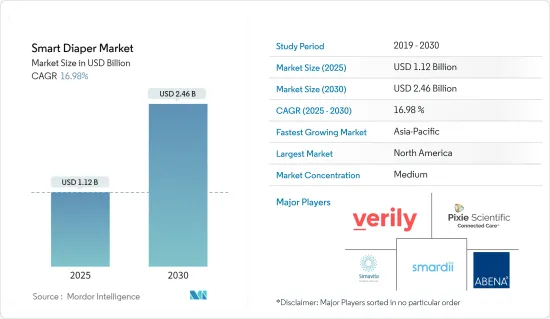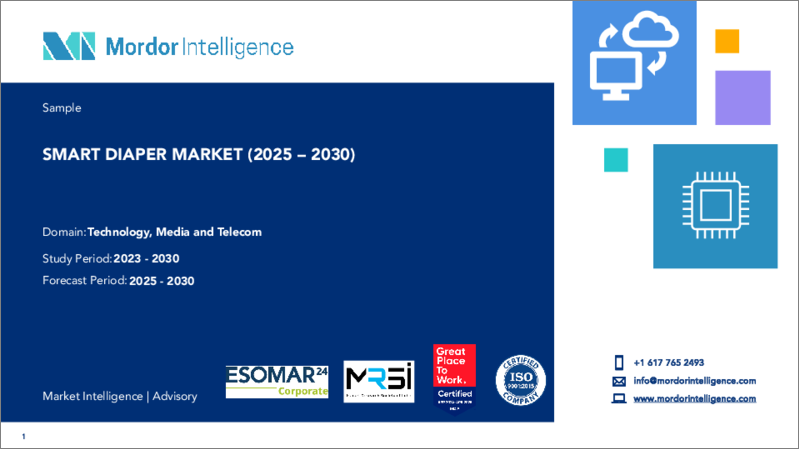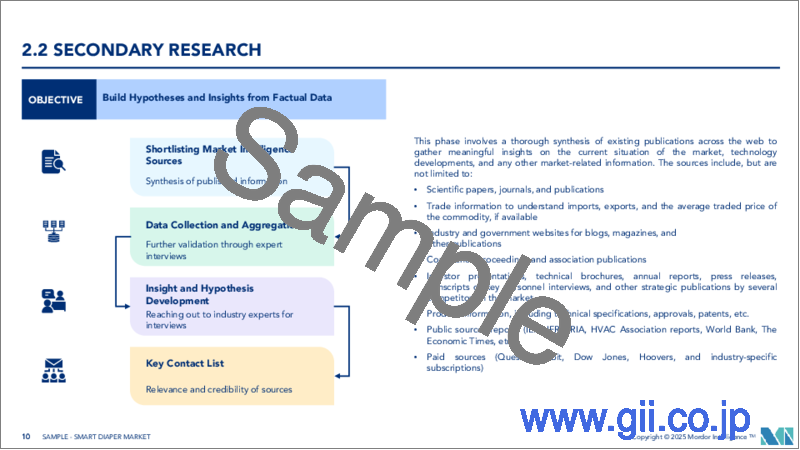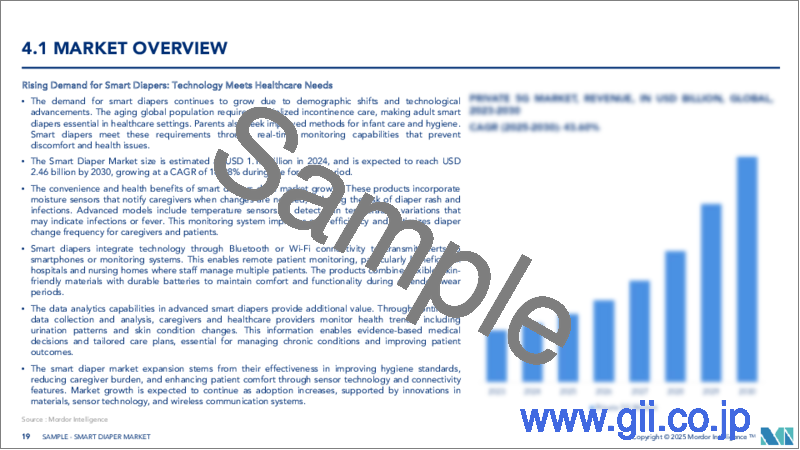|
|
市場調査レポート
商品コード
1643115
スマートおむつ:市場シェア分析、産業動向・統計、成長予測(2025~2030年)Smart Diaper - Market Share Analysis, Industry Trends & Statistics, Growth Forecasts (2025 - 2030) |
||||||
カスタマイズ可能
適宜更新あり
|
|||||||
| スマートおむつ:市場シェア分析、産業動向・統計、成長予測(2025~2030年) |
|
出版日: 2025年01月05日
発行: Mordor Intelligence
ページ情報: 英文 122 Pages
納期: 2~3営業日
|
全表示
- 概要
- 目次
スマートおむつの市場規模は2025年に11億2,000万米ドルと推定され、予測期間中(2025~2030年)のCAGRは16.98%で、2030年には24億6,000万米ドルに達すると予測されます。

世界市場は、核家族と共働き家庭の育児を支援する技術の利用が拡大していることが背景にあります。
主要ハイライト
- スマートおむつは、おむつ交換の必要性やおむつが濡れた場合のアラートを個人に提供する下着の一形態です。スマートおむつのシステムは、モバイルアプリケーションに接続されたセンサで構成されています。センサが漏れを検知すると、速やかに特定し、アラームを作動させています。スマートおむつの市場は、可処分所得の増加、豊かな国々での高齢化、新興国での人口増加により拡大しています。さらに、この技術革新は、コンチネンスケアにおける最も顕著な進歩のひとつと考えられています。病院、クリニック、介護施設でのスマートおむつの利用拡大が、スマートおむつ市場の成長に寄与すると予想されます。
- スマートおむつは、RFIDセンサを搭載し、赤ちゃんの着替えが必要なときに親に通知する便利な下着です。しかし、おむつが汚れた場合、濡れたおむつ2枚分に相当するため、赤ちゃんの肌荒れや不快感を防ぐために早急な対応が求められます。スマートおむつは、長時間のおむつ使用による潜在的な肌荒れや関連する問題を回避し、赤ちゃんの健康を確保するために親を支援する手段として役立ちます。
- 高齢者の拡大は、今後数年間に予想される市場成長に影響を与える可能性が高いです。家族が赤ちゃんのケアに独創的なアプローチを模索し、高齢者が増加するにつれて、先進的な特徴と機能性を備えたスマートおむつの需要はエスカレートし、それによって世界のスマートおむつ市場の全体的な市場成長が促進されると予測されます。
- スマートおむつ産業の主要製品カテゴリーは、乳幼児用おむつと成人用おむつの両方を包含しています。成人用おむつは、認知症、尿失禁、便失禁、下痢、移動制限などの日常的課題を経験する高齢者を支援するために特別に設計されています。スマートおむつは、効果的な介護を促進するだけでなく、便秘、肌荒れ、アレルギー、失禁などの健康状態の早期発見を支援する可能性を秘めています。
- 市場の成長を妨げているのは、消費者の商品知識が不十分であることと、スマート接続型おむつが従来型おむつに比べて法外に高価であるという2つの主要障害です。さらに、成人用に設計されたスマートおむつには、脱水症状の長期化、尿路感染症の再発、腎臓問題の潜在的開発といった特有の欠点があります。
- COVID-19の大流行は市場にプラスの影響を与えました。この大流行の影響により、保育事業は解体され、多くの代理店や専門の保育業者に委託されるようになりました。様々なプラットフォームが適切に審査された保育者を提供しようとしたが、パンデミックの脅威により、親が直接赤ちゃんの世話に関わらざるを得なくなりました。これは市場にプラスの影響を与えると予想されます。
スマートおむつ市場の動向
ベビーケアの高まりが市場促進要因に
- 乳幼児の健康は最も重要であり、十分な注意が必要です。そのため、多くの企業がスマートおむつにAlert Plusのような先進技術を採用しています。このような技術革新の一例として、スマートおしっこセンサがあります。このセンサは、温度と湿度レベルに関する情報をタイムリーに提供する独自のアルゴリズムを組み込んでいます。これらのおむつ技術は、アプリケーションによる統計データの作成を可能にし、おむつの使用状況や排便活動の追跡を容易にし、おむつ交換が必要な場合にはアラートを発します。
- スマートおむつ市場は、先進国と新興国の双方における出生率の上昇とインターネット利用の普及により成長を遂げています。さらに、IoTデバイスの台頭とスマートコネクテッド製品に対する消費者の需要の高まりが、市場のさらなる拡大を促すと予想されます。さらに、スマートおむつが尿失禁やおむつの水分量をモニタリングして皮膚の病気を予防する可能性は、市場の成長にとって魅力的な機会となります。
- 乳幼児用スマートおむつの需要は、ベビーケア製品への需要の高まりと新生児の世界の人口拡大により、大幅な成長を遂げています。市場は、ベビー用おむつのメーカーや小売業者にとって有利となる様々な機会や動向の出現を目の当たりにしています。これらのメーカーは先進技術に投資し、吸収性、快適性、柔軟性を向上させた優れた品質のおむつを製造することで、目の肥えた消費者の要求に応えています。例えば、WorldMapperによると、2022年の出生数はインドが2,300万人で最多を記録しました。次いで中国が1,000万人、ナイジェリアが800万人、パキスタンが640万人、インドネシアが450万人となっています。
- さらに、スマートおむつは乳幼児のデリケートな肌のかぶれやアレルギーを防ぐのに役立ちます。さらに、このシステムは、母親や介護者が排泄パターンを特定し、乳幼児に早い段階で自然なプロセスを訓練するのを助ける。スマートおむつは、濡れや腐敗を防ぎ、睡眠や呼吸のパターンをモニターします。メーカーは現在、余分な水分を吸収する毛羽のないおむつを開発しています。
- eコマース・チャネルは、スマートフォンとインターネット・アクセスの普及に後押しされ、ベビー用おむつ製品の重要な流通チャネルとして浮上してきました。オンラインショッピングの利便性と簡便性により、消費者はこのプラットフォームを通じてベビー用おむつを購入する傾向が強まっており、メーカーはオンラインでの知名度を高める機会を得ています。
アジア太平洋が急成長市場になる展望
- アジア太平洋は、予測期間中に最も急速な成長を遂げると予測されています。この地域の市場は、新しいセンサ技術を開発する数多くの新興企業の出現によって推進されています。市場の主要促進要因は、同地域における人口の増加と核家族の普及です。台湾、韓国、オーストラリアは、この製品の新興市場として認識されています。さらに、乳幼児、成人、高齢者向けの高度介護技術の採用が増加していることも、アジア太平洋の需要を大きく押し上げると予想されます。
- 世界人口の50%以上がアジアに居住しており、2050年までに都市部の人口が最も多くなると予測されている地域です。インドと中国は世界で最も人口の多い国であり、アジアは特に予測期間中、相当数の乳幼児が増えるため、大きな市場機会をもたらすと予想されます。例えば、国際通貨基金(IMF)は、インドの人口は2022年までに約14億663万人に達し、その後もさらなる増加が見込まれると予測しています。その結果、同地域の人口増加は、スマートおむつの需要増加を促進すると考えられます。
- 日本、中国、インド、韓国といったアジア太平洋の主要国は、人口増加と医療水準の向上により、乳幼児死亡率の抑制に成功しています。さらに、人口動態が農村部から都市部へとシフトしていることも、アジア太平洋諸国におけるインテリジェントおむつの需要を後押ししています。国務院委員会の報告によると、中国の乳幼児死亡率は2020年の1,000人当たり5.4人から2021年には1,000人当たり5人に減少しており、今後も減少が続くと予測されています。
- ヒンダウィ出版社によると、生後24ヶ月以下の乳幼児を対象としたエコおむつは、インドや中国で広く利用されており、フィリピンや日本もこれに続いています。導電糸とセンサを組み込むことで、これらのおむつは効果的に水分レベルを検知することができ、かなりの水分が検知されるとアラームが作動します。
- この地域は高齢者の割合が高いため、市場開拓の可能性は大きいです。日本、中国、インド、韓国などのアジア太平洋の主要国では、高齢化率が上昇し、医療水準が向上しています。さらに、スマートおむつ市場は、特におむつの外装に取り付けられたワイヤレスまたはBluetooth対応の水分センサの形で、技術的進歩の増加傾向を経験しています。これらのセンサは、長距離インターネット接続を可能にする耐久性のあるバッテリーによって支えられています。さらに、「Report of the Technical Group on Population Projections for India and States 2011-2036」に記載されているように、インドの高齢者は2021年には約1億3,800万人に達すると予測されており、その内訳は男性6,700万人、女性7,100万人です。この数は2031年までに約5,600万人増加すると予測されています。同様に、中国政府の報告によると、14億4,000万人の中国の人口は急速に高齢化が進んでいます。現在、65歳以上の高齢者は人口の12.0%(1億7,300万人)を占めているが、2050年には26.1%(3億6,600万人)に増加すると予想されています。
- 高齢者の増加が市場需要に大きく貢献すると予想されます。予測期間中、高齢者向けの介護施設、医療機関、クリニックが市場を牽引すると予想されます。さらに、WHOのデータによると、2025年までにアジアの人口の18%が65歳以上になると予想されており、2010年の水準から11%増加することになります。この動向は、特に同地域で核家族化が進み、スマートおむつへの需要が高まるにつれて、同市場に大きなビジネス機会をもたらすと予想されます。
スマートおむつ産業概要
調査対象市場は半連結です。同市場では、進化する消費者の需要に対応するため、数多くの製品の発売やイノベーションが行われています。
2023年2月、ペンシルベニア州立大学の研究開発者は、スマートおむつとして知られる技術的に先進的おむつを開発しました。このおむつは、塩化ナトリウムを浸透させた前処理済みの紙で構成され、黒鉛でトレースされた回路基板の外形と小型リチウム電池を備えています。液体に触れると、黒鉛が塩化ナトリウムと反応し、電子が流れてセンサが作動します。
その他の特典
- エクセル形式の市場予測(ME)シート
- 3ヶ月のアナリストサポート
目次
第1章 イントロダクション
- 調査の前提条件と市場定義
- 調査範囲
第2章 調査手法
第3章 エグゼクティブサマリー
第4章 市場洞察
- 市場概要
- 産業の魅力-ポーターのファイブフォース分析
- 買い手/消費者の交渉力
- 供給企業の交渉力
- 新規参入業者の脅威
- 代替品の脅威
- 競争企業間の敵対関係の強さ
- COVID-19の産業への影響評価
第5章 市場力学
- 市場促進要因
- 新興諸国における高齢者の増加
- 新興市場における高い出生率と可処分所得の増加
- 市場抑制要因
- 長期使用に伴う感染症や腎臓障害が市場成長の抑制要因になる可能性
第6章 市場セグメンテーション
- エンドユーザー産業
- 乳幼児
- 成人
- 地域
- 北米
- 欧州
- アジア太平洋
- その他
第7章 競合情勢
- 企業プロファイル
- Smardii
- Pixie Scientific
- Simavita Limited
- Abena Holding A/S
- Verily Life Sciences(Alphabet Inc.)
- Monit Corp.
- Sinopulsar Technology Inc.
- Hunan Cosom Care Products Co., Ltd.
第8章 投資分析
第9章 市場機会と今後の動向
The Smart Diaper Market size is estimated at USD 1.12 billion in 2025, and is expected to reach USD 2.46 billion by 2030, at a CAGR of 16.98% during the forecast period (2025-2030).

The global market is propelled by the growing utilization of technology to aid nuclear and working families in regard to childcare.
Key Highlights
- A smart diaper is a form of undergarment that provides individuals with alerts regarding the need for a diaper change or if it becomes wet. The system of a smart diaper consists of sensors that are connected to mobile applications. Once a sensor detects a leak promptly identifies and activates an alarm. The market for smart diapers is expanding due to the rise in disposable incomes, the aging population in affluent countries, and the growing population in emerging nations. Furthermore, this innovation is considered one of the most remarkable advancements in continence care. It is expected that the increased utilization of smart diapers in hospitals, clinics, and nursing homes will contribute to the growth of the smart diaper market.
- A smart diaper is an advantageous undergarment equipped with an RFID sensor that notifies parents when it is necessary to change the baby. However, in the case of a soiled diaper, equivalent to two wet diapers, immediate action is required to prevent skin irritation and discomfort for the baby. Smart diapers serve as a means to assist parents in averting potential skin irritations and associated issues caused by prolonged diaper usage, ensuring the baby's well-being.
- The expanding senior population will likely influence the anticipated market growth in the forthcoming years. As families search for inventive approaches to baby care and with the rise in the elderly population, the demand for smart diapers equipped with advanced features and functionalities is projected to escalate, thereby propelling the overall market growth in the global smart diapers market.
- The primary product categories within the smart diaper industry encompass both infant and adult diapers. Adult diapers are specifically designed to assist elderly individuals who experience daily challenges such as dementia, urinary or fecal incontinence, diarrhea, or limited mobility. In addition to facilitating effective care, smart diapers have the potential to aid in the early detection of health conditions, including constipation, skin irritations, allergies, and incontinence.
- The market's growth is hindered by two main obstacles: insufficient consumer product knowledge and the exorbitant cost of smart-connected diapers in comparison to conventional ones. Moreover, smart diapers designed for adults present specific drawbacks such as prolonged dehydration, recurrent urinary tract infections, and the potential development of renal issues.
- The COVID-19 pandemic outbreak affected the market positively. The effect of the outbreak led to the breakup of the childcare business, which was outsourced to many agencies and professional childcare providers. Though various platforms tried to provide properly screened caregivers, the threat of the pandemic forced parents to get involved in baby care directly. This was expected to impact the market positively.
Smart Diaper Market Trends
The Rising Baby Care Will Act as a Major Driver of the Market
- The well-being of infants is of utmost importance and requires diligent attention. Consequently, numerous corporations employ advanced technologies like Alert Plus in smart diapers. An example of such innovation is the Smart Pee sensor, which incorporates a unique algorithm to provide timely information on temperature and humidity levels. These diaper technologies enable the creation of statistical data through applications, facilitating the tracking of diaper usage and bowel activity and issuing alerts when a diaper change is necessary.
- The market for smart diapers is experiencing growth due to increasing birth rates in both developed and developing nations and the growing prevalence of Internet usage. Furthermore, the rise of IoT devices and heightened consumer demand for smart connected products are expected to drive market expansion further. Additionally, the potential for smart diapers to monitor urine incontinence and diaper moisture levels to prevent skin ailments presents an attractive opportunity for market growth.
- The demand for smart diapers for infants is witnessing substantial growth owing to the escalating demand for baby care products and the expanding global population of newborns. The market is witnessing the emergence of various opportunities and trends that can prove advantageous for manufacturers and retailers of baby diapers. These manufacturers are investing in advanced technologies to create diapers of superior quality, offering improved absorbency, comfort, and flexibility, thereby catering to the requirements of discerning consumers. For instance, In 2022, India recorded the highest number of births, with 23 million, as per WorldMapper. China followed with 10 million, while Nigeria, Pakistan, and Indonesia registered 8 million, 6.4 million, and 4.5 million births respectively.
- Furthermore, smart diapers are beneficial for infants as they aid in preventing skin rashes and allergies on their delicate skin. Additionally, this system assists mothers and caregivers in identifying excretion patterns and training infants in natural processes at an early stage. Smart diapers prevent wetness and spoilage and monitor sleeping and breathing patterns. Manufacturers are currently developing fluffless diapers that absorb excess liquids.
- The e-commerce channel has emerged as a crucial distribution avenue for baby diaper products, propelled by the increasing prevalence of smartphones and internet access. The convenience and simplicity of online shopping have led consumers to increasingly opt to purchase baby diapers through this platform, giving manufacturers an opportunity to enhance their online visibility.
Asia-Pacific is Expected to be the Fastest Growing Market
- The Asia Pacific region is projected to experience the most rapid growth rate during the forecasted period. The market in the region is being propelled by the emergence of numerous startups developing new sensor technologies. The primary drivers of the market are the growing population and the prevalence of nuclear families in the region. Taiwan, Korea, and Australia are identified as emerging markets for this product. Furthermore, the increasing adoption of advanced care technologies for infants, adults, and the elderly is expected to drive significant demand in the Asia-Pacific region.
- Over 50 percent of the global population is comprised of individuals residing in Asia, a region projected to have the highest urban population by 2050. With India and China being the most populous countries in the world, Asia is anticipated to present significant market opportunities, particularly in the forecasted period, due to the addition of a substantial number of infants. For instance, the International Monetary Fund predicts that India's population will reach approximately 1,406.63 million by 2022, with further growth expected in subsequent years. Consequently, the rising population in the region will drive an increased demand for smart diapers.
- Prominent nations within the Asia-Pacific region, such as Japan, China, India, and South Korea, have successfully curtailed infant mortality rates owing to population expansion and the advancement of healthcare standards. Moreover, the demographic shift from rural to urban localities propelled the demand for intelligent diapers in Asia-Pacific countries. Notably, China's infant mortality rate has declined from 5.4 per 1,000 in 2020 to 5 per 1,000 in 2021, as the State Council Commission reported, and is projected to continue decreasing in the foreseeable future.
- According to the Hindawi Publishing Corporation, eco-diapers designed for infants aged 24 months and below are extensively utilized in India and China, with the Philippines and Japan following suit. By incorporating conductive yarns and sensors, these diapers can effectively detect moisture levels, triggering an alarm when significant moisture is detected.
- The market development potential in the region is significant due to the substantial proportion of elderly residents. Prominent nations in the Asia-Pacific region, such as Japan, China, India, and South Korea, have witnessed a rise in the aging population and improved healthcare standards. Additionally, the smart diaper market is experiencing a growing trend of technological advancements, particularly in the form of wireless or Bluetooth-enabled moisture sensors attached to the diaper's exterior. These sensors are supported by durable batteries that enable long-range internet connectivity. Furthermore, as stated in the Report of the Technical Group on Population Projections for India and States 2011-2036, the elderly population in India is projected to reach approximately 138 million individuals in 2021, comprising 67 million males and 71 million females. This number is anticipated to increase by approximately 56 million individuals by 2031. Similarly, the Chinese government reports that China's population of 1.44 billion is experiencing rapid aging. Individuals aged 65 years and older currently comprise 12.0 percent (173 million) of the people, which is expected to rise to 26.1 percent (366 million) by 2050.
- The increasing geriatric population is anticipated to make a substantial contribution to market demand. The market is expected to be driven by nursing homes, healthcare institutions, and clinics catering to elderly patients during the forecast period. Additionally, WHO data reveals that by 2025, 18 percent of Asia's population will be aged 65 or older, representing an 11 percent increase from 2010 levels. This trend is expected to create significant opportunities for the market, particularly as families become more nuclear in the region, resulting in a demand for smart diapers.
Smart Diaper Industry Overview
The studied market is semi - consolidated. The market has been experiencing a number of product launches and innovations to meet evolving consumer demands.
In February 2023, Researchers at Penn State University developed a technologically advanced diaper known as a smart diaper, which incorporates a sensor that sends an alert to a mobile device when it becomes wet. The diaper is constructed from pre-treated paper infused with sodium chloride and features a circuit board outline traced with graphite and a small lithium battery. Upon contact with liquid, the graphite reacts with the sodium chloride, causing electrons to flow and activating the sensor.
Additional Benefits:
- The market estimate (ME) sheet in Excel format
- 3 months of analyst support
TABLE OF CONTENTS
1 INTRODUCTION
- 1.1 Study Assumptions and Market Definition
- 1.2 Scope of the Study
2 RESEARCH METHODOLOGY
3 EXECUTIVE SUMMARY
4 MARKET INSIGHTS
- 4.1 Market Overview
- 4.2 Industry Attractiveness - Porter's Five Forces Analysis
- 4.2.1 Bargaining Power of Buyers/Consumers
- 4.2.2 Bargaining Power of Suppliers
- 4.2.3 Threat of New Entrants
- 4.2.4 Threat of Substitute Products
- 4.2.5 Intensity of Competitive Rivalry
- 4.3 Assessment of Impact of COVID-19 on the Industry
5 MARKET DYNAMICS
- 5.1 Market Drivers
- 5.1.1 Large Geriatric Population in Developed Countries
- 5.1.2 High Birth Rates and Rise in Disposable Incomes in Emerging Markets
- 5.2 Market Restraints
- 5.2.1 Infections and Kidney Problems Associated with their Prolonged Use might Act as a Restraint for Market Growth
6 MARKET SEGMENTATION
- 6.1 End-User Industry
- 6.1.1 Baby
- 6.1.2 Adult
- 6.2 Geography
- 6.2.1 North America
- 6.2.2 Europe
- 6.2.3 Asia-Pacific
- 6.2.4 Rest of the World
7 COMPETITIVE LANDSCAPE
- 7.1 Company Profiles
- 7.1.1 Smardii
- 7.1.2 Pixie Scientific
- 7.1.3 Simavita Limited
- 7.1.4 Abena Holding A/S
- 7.1.5 Verily Life Sciences (Alphabet Inc.)
- 7.1.6 Monit Corp.
- 7.1.7 Sinopulsar Technology Inc.
- 7.1.8 Hunan Cosom Care Products Co., Ltd.





